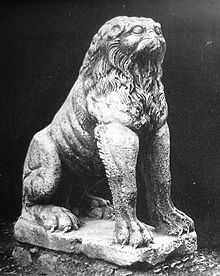Boukoleon Palace
.JPG)

.JPG)
The Palace of Boukoleon (Greek: Βουκολέων) or Bucoleon was one of the Byzantine palaces in Constantinople. It was probably built by Theodosius II in the 5th century.
The palace sits on the shore of Marmara Sea. Hormisdas is an earlier name of the place. The name Bucoleon was probably attributed after the end of the 6th century under Justinian I, when the small harbour in front of the palace, which is now filled, was constructed. [citation needed] According to tradition, a statue featuring a bull and a lion stood there, giving the port its name (βους and λέων are Greek for "bull" and "lion" respectively). "House of Hormisdas" and "House of Justinian" are other names referring to Bucoleon Palace.
Emperor Theophilos, among his other works, rebuilt and expanded the palace, adding a large façade on top of the seaward walls. The ruins suggest a balcony looking out to the sea was present, accessible through three marble-framed doorways, still visible today.
In the 1204 sacking of Constantinople during the Fourth Crusade, Bucoleon was taken by Boniface of Montferrat who:
"rode all along the shore to the palace of Bucoleon, and when he arrived there it surrendered, on condition that the lives of all therein should be spared. At Bucoleon were found the larger number of the great ladies who had fled to the castle, for there were found the sister of the King of France, who had been empress, and the sister of the King of Hungary, who had also been empress, and other ladies very many. Of the treasure that was found in that palace I cannot well speak, for there was so much that it was beyond end or counting." (Villehardouin)
Among the prizes, then, was Princess Margaret, daughter of Bela III of Hungary, whom Boniface married. During the subsequent Latin Empire (1204–1261), the Bucoleon continued to be used as an imperial residence. After the recapture of the city by Michael VIII Palaiologos, however, the palace, along with the entire Great Palace complex, was gradually abandoned in favour of the Blachernae Palace.
When Mehmet II, the Ottoman emperor, entered the city in 1453, it was noted that the then-famous palace still stood, albeit in ruins. The ruins of the palace were partially destroyed in 1873 to make way for the railway line to Sirkeci.
Literature
- Cyril Mango. The Palace of the Boukoleon. In: Cahiers Archéologiques 45, 1997.
External links
![]() Media related to Palace of Boukoleon at Wikimedia Commons
Media related to Palace of Boukoleon at Wikimedia Commons
- 3D reconstruction of the palace from Byzantium 1200
- Rescue Archeology on Istanbul
- Photo of the central facade of the palace before its demolition. Taken by Pierre Trémaux (1818-1895), ca. 1862-1868
- Panorama of the site from the Columbia University of New York
Coordinates: 41°00′11″N 28°58′31″E / 41.00306°N 28.97528°E
| ||||||||||||||||||||